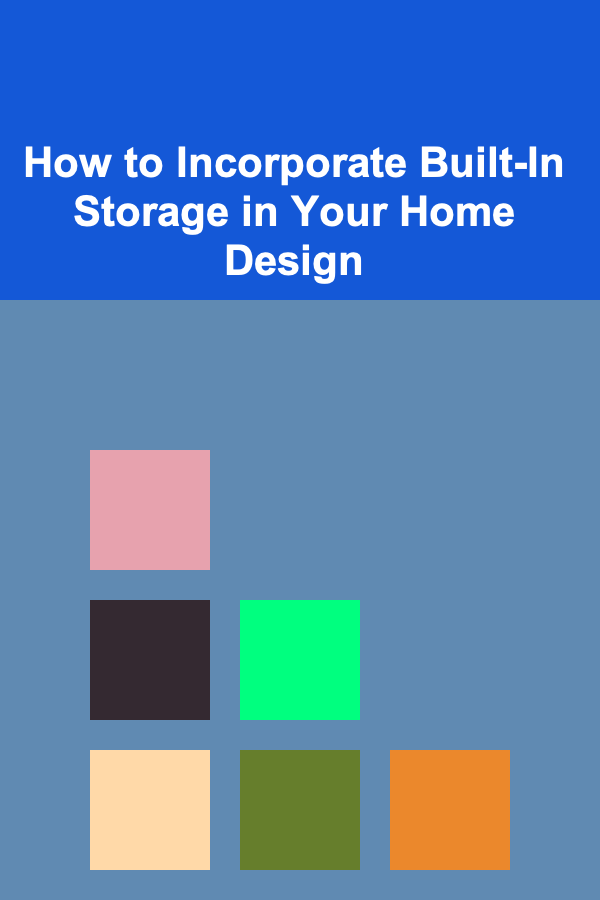
How to Incorporate Built-In Storage in Your Home Design
ebook include PDF & Audio bundle (Micro Guide)
$12.99$8.99
Limited Time Offer! Order within the next:

Built-in storage is an effective way to maximize space and enhance the functionality of your home. Whether you live in a cozy apartment or a sprawling house, incorporating built-in storage solutions not only streamlines organization but also contributes to the aesthetic appeal of your interiors. This comprehensive guide will explore various strategies for integrating built-in storage into your home design, from planning and design considerations to practical implementation tips.
Understanding the Importance of Built-In Storage
1. Space Optimization
One of the primary advantages of built-in storage is its ability to optimize available space:
- Custom Fit: Built-ins can be designed to fit specific areas, utilizing every inch effectively, especially in challenging spaces like corners and alcoves.
- Maximized Vertical Space: High shelves and cabinets can take advantage of vertical space that is often underutilized in traditional furniture arrangements.
2. Enhanced Aesthetic Appeal
Built-in storage offers a polished look that enhances the overall design of your home:
- Seamless Integration: Well-designed built-ins can blend perfectly with your existing decor, creating a cohesive look.
- Customization: They can be tailored in terms of materials, colors, and styles to reflect your personal taste.
3. Increased Property Value
Incorporating built-in storage can increase the value of your home:
- Desirability: Potential buyers often appreciate built-in features, viewing them as a sign of thoughtful design.
- Functionality: Homes with ample storage solutions tend to be more appealing in today's market, where clutter-free living is highly valued.
4. Improved Organization
Built-in storage promotes better organization within your home:
- Defined Spaces: Each item has a designated place, making it easier to keep track of belongings.
- Reduced Clutter: With designated storage solutions, it's easier to maintain a tidy and organized environment.
Assessing Your Needs
Before diving into the specifics of incorporating built-in storage, it's essential to assess your individual needs and preferences:
1. Identify Areas Needing Storage
Take stock of the rooms in your home that could benefit from additional storage:
- Common Problem Areas: Focus on areas such as entryways, living rooms, kitchens, bedrooms, and bathrooms where clutter tends to accumulate.
- Specific Needs: Consider what items need storage---books, toys, kitchenware, clothing, etc.---to tailor solutions accordingly.
2. Evaluate Available Space
Understanding the dimensions and layout of your home is crucial for successful design:
- Measure Dimensions: Take accurate measurements of wall space, ceiling heights, and any architectural features that could impact design choices.
- Consider Traffic Flow: Ensure that added storage does not impede movement throughout the space.
3. Define Your Style Preferences
Your storage solutions should complement your home's overall aesthetic:
- Design Styles: Decide whether you prefer modern, minimalist, rustic, or traditional designs, as this will influence material and color choices.
- Personal Touches: Think about how built-ins can reflect your personality, perhaps through custom finishes or decorative hardware.
Types of Built-In Storage Solutions
There are numerous types of built-in storage solutions that can enhance your home design. Below are some common options:
1. Custom Cabinets
Custom cabinets can be created to suit any room in your home:
a. Kitchen Cabinets
- Maximize Efficiency: Design cabinets that utilize corners and vertical space to accommodate all kitchenware.
- Open Shelving Options: Incorporate open shelving for frequently used items while keeping less-used items behind closed doors.
b. Living Room Built-Ins
- Entertainment Centers: Create built-in units around fireplaces or media centers for a streamlined look.
- Display Shelves: Use adjustable shelves for displaying books, photos, and collectibles.
2. Bookshelves
Bookshelves can serve both functional and decorative purposes:
a. Full-Wall Libraries
- Floor-to-Ceiling Options: Utilize an entire wall for bookshelves that can accommodate a large collection of books or decorative items.
- Integrated Ladders: For high shelves, consider incorporating a rolling ladder for easy access.
b. Nook Shelves
- Reading Nooks: Build small shelves into reading areas for a cozy touch.
- Window Seats: Integrate bookshelves into window seats for a functional yet inviting space.
3. Closets
Closet systems can be customized for maximum functionality:
a. Walk-In Closets
- Built-In Drawers: Incorporate drawers for smaller items, maximizing vertical space while keeping things organized.
- Shoe Racks: Design dedicated shoe storage solutions, using shelving or pull-out racks.
b. Reach-In Closets
- Shelving Units: Use adjustable shelving to easily reorganize as storage needs change.
- Hanging Rods: Optimize hanging space by installing multiple rods at varying heights.
4. Entryway Storage
Entryways can greatly benefit from built-in storage solutions:
a. Mudrooms
- Cubbies: Create cubbies for each family member to store bags, shoes, and coats.
- Bench Seating: Incorporate seating with hidden storage underneath for added functionality.
b. Wall Hooks
- Coat Racks: Install built-in coat racks with hooks for easy access to outerwear.
- Umbrella Stands: Integrate umbrella storage into built-ins to keep things tidy.
5. Bathroom Vanities
Built-in storage in bathrooms can enhance organization and style:
a. Under-Sink Storage
- Drawer Systems: Create drawer units beneath sinks for toiletries, cleaning supplies, and towels.
- Open Shelving: Utilize open shelving for easy access to frequently used items while maintaining a clean look.
b. Medicine Cabinets
- Mirrored Cabinets: Use mirrored medicine cabinets to create a functional and visually appealing focal point.
- Horizontal Shelving: Incorporate horizontal shelves above the sink for additional storage without taking up floor space.
Planning Your Built-In Storage
Once you have identified your needs and preferred types of storage, it's time to plan the specifics:
1. Sketch Your Ideas
Visualizing your plans can help refine your ideas:
- Draft Layouts: Create scaled drawings or sketches of potential built-in storage solutions.
- Use Design Software: Consider using interior design software or apps to visualize your concepts more accurately.
2. Consider Functionality
Ensure your designs promote ease of use and accessibility:
- Height Considerations: Plan for storage heights that align with the users' needs, especially for children or individuals with mobility challenges.
- Ease of Access: Avoid deep shelves unless they have sliding mechanisms or rolling units to retrieve stored items easily.
3. Material Selection
Choosing the right materials is critical for durability and aesthetics:
- Wood Types: Solid wood is durable and can be stained or painted to match your decor.
- Finishes: Choose finishes that are easy to clean and maintain, especially in high-traffic areas like kitchens and bathrooms.
4. Work with Professionals
Consider collaborating with professionals for the best results:
- Interior Designers: Engage an interior designer to help translate your vision into actionable plans.
- Carpenters or Contractors: Hire skilled craftsmen for custom-built options to ensure quality construction.
Implementation Tips for Built-In Storage
Bringing your built-in storage designs to life requires careful consideration and execution:
1. Budgeting
Establish a budget before beginning your project:
- Cost Estimates: Gather estimates for materials, labor, and any additional costs associated with installation.
- Prioritize Needs: Determine which built-in storage options are most important and allocate funds accordingly.
2. Start Small
If you're new to built-in projects, consider starting small:
- Pilot Projects: Tackle one area first, such as a bookshelf or entryway storage, to test your ideas.
- Gradual Expansion: Once you gain confidence, expand your projects to other areas of the home.
3. Functionality Testing
Test the functionality of your built-ins once installed:
- User Feedback: Gather input from family members to determine if adjustments are needed.
- Reassess Layouts: Be prepared to rearrange storage elements depending on how well they work in practice.
4. Personalization
Make your built-ins feel like home:
- Decorative Touches: Add personal touches such as artwork, plants, or decorative items on shelves to enhance the space.
- Lighting Features: Consider adding integrated lighting to highlight special items or improve visibility.
Maintaining Your Built-In Storage
Successful maintenance ensures your built-in storage remains functional over time:
1. Regular Cleaning
Implement regular cleaning routines to keep built-ins looking their best:
- Dusting and Wiping: Schedule routine dusting and wiping down of surfaces to prevent buildup.
- Organize Periodically: Set aside time every season to reassess and reorganize built-in storage.
2. Monitor Wear and Tear
Keep an eye on the condition of built-ins:
- Inspect Regularly: Check for signs of wear, water damage, or loose hardware and address issues promptly.
- Preventive Measures: Use coasters, dividers, or liners to protect shelves and surfaces.
3. Update as Necessary
Be ready to update or modify built-in storage as needs change:
- Adaptation for Life Changes: As family dynamics shift (e.g., children grow), adapt your storage solutions to accommodate new requirements.
- Seasonal Adjustments: Rotate seasonal or holiday items into built-ins to refresh the space.
Conclusion
Incorporating built-in storage into your home design can transform your space, enhancing both functionality and aesthetics. By understanding the importance of built-ins, assessing your needs, exploring various styles, and carefully planning and implementing your designs, you can create beautiful and efficient storage solutions tailored to your lifestyle.
Through thoughtful integration of built-in storage, you can achieve a clutter-free environment that not only meets your organizational needs but also adds value and character to your home. Embrace the possibilities of built-in storage, and enjoy the benefits of a beautifully organized space that reflects your unique style.

How to Create a Financial Independence Plan
Read More
How to Create a Successful Online Store: A Beginner's Guide
Read More
How to Update Your Address on All Important Accounts
Read More
How to Use Art and Decor to Tell a Story in Your Staging
Read More
How to Manage Homework Struggles
Read More
Finding Affordable Vacation Rentals: A Comprehensive Guide
Read MoreOther Products

How to Create a Financial Independence Plan
Read More
How to Create a Successful Online Store: A Beginner's Guide
Read More
How to Update Your Address on All Important Accounts
Read More
How to Use Art and Decor to Tell a Story in Your Staging
Read More
How to Manage Homework Struggles
Read More